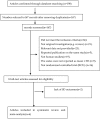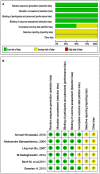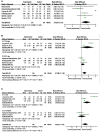Positive Effect of Probiotics on Constipation in Children: A Systematic Review and Meta-Analysis of Six Randomized Controlled Trials
- PMID: 28503492
- PMCID: PMC5408016
- DOI: 10.3389/fcimb.2017.00153
Positive Effect of Probiotics on Constipation in Children: A Systematic Review and Meta-Analysis of Six Randomized Controlled Trials
Abstract
Context: Constipation in children is a prevalent, burdensome, and psychologically important pediatric issue, the treatment of which remains a global challenge. The use of probiotics has been reported for management of the gastrointestinal microbiota. Objective: This study reviewed the existing literatures of 6 Randomized Control Trials (RCTs) to ascertain some baseline understanding and available information for the effects of probiotics on stool frequency and consistency in children with constipation. Data Sources: PubMed, Springer, Elsevier Science, Cochrane Library, Scopus, Ovid (Medline, EMBASE, PsycINFO), Orbis, and Web of Science from the earliest record in each database to 15 September, 2016. Study selection: Eligible studies were randomized controlled trials that compared the effect of probiotics interventions to any control intervention on stool frequency and consistency. Data Extraction: Studies were identified by searching electronic databases. The meta-analysis was performed by Review Manager 5.3 software using a randomized model. Results: Six studies were identified. The use of probiotics significantly increased the stool frequency [mean difference (MD), 0.73; 95% confidence interval (CI), 0.14-1.31; P = 0.02]. Subgroup assessment showed a significantly increased stool frequency in Asian patients (MD, 1.18; 95% CI, 0.33-2.02; P = 0.006), but no significant difference in stool consistency (MD, -0.07; 95% CI, -0.21-0.06; P = 0.27). Limitations: Only six RCTs met the criteria and were included. Each RCT in this study was performed in a different country, and some of the included studies had a small sample size, which might have influenced the reliability and validity of the conclusions. Conclusion: The present study shows that probiotics increase stool frequency and have beneficial effects in Asian children. However, caution is needed when interpreting these outcomes because of the existence of heterogeneity. Evidence from larger samples and more adequately powered RCTs with results obtained by standardized measurements are necessary to determine which species and dosage of probiotics and what length of treatment are most efficacious for constipation in children.
Keywords: children; constipation; meta-analysis; probiotics; randomized controlled trial.
Figures





Similar articles
-
Meta-analysis of randomized controlled trials of the effects of probiotics on functional constipation in adults.Clin Nutr. 2020 Oct;39(10):2960-2969. doi: 10.1016/j.clnu.2020.01.005. Epub 2020 Jan 14. Clin Nutr. 2020. PMID: 32005532
-
The efficacy and safety of probiotics for patients with constipation-predominant irritable bowel syndrome: A systematic review and meta-analysis based on seventeen randomized controlled trials.Int J Surg. 2020 Jul;79:111-119. doi: 10.1016/j.ijsu.2020.04.063. Epub 2020 May 6. Int J Surg. 2020. PMID: 32387213
-
When poorly conducted systematic reviews and meta-analyses can mislead: a critical appraisal and update of systematic reviews and meta-analyses examining the effects of probiotics in the treatment of functional constipation in children.Am J Clin Nutr. 2019 Jul 1;110(1):177-195. doi: 10.1093/ajcn/nqz071. Am J Clin Nutr. 2019. PMID: 31127810 Review.
-
Efficacy of Probiotics Compared With Pharmacological Treatments for Maintenance Therapy for Functional Constipation in Children: A Systematic Review and Network Meta-analysis.Nutr Rev. 2025 Jun 1;83(6):1006-1034. doi: 10.1093/nutrit/nuae119. Nutr Rev. 2025. PMID: 39348282 Free PMC article.
-
Efficacy in bowel movement and change of gut microbiota on adult functional constipation patients treated with probiotics-containing products: a systematic review and meta-analysis.BMJ Open. 2024 Jan 18;14(1):e074557. doi: 10.1136/bmjopen-2023-074557. BMJ Open. 2024. PMID: 38238054 Free PMC article.
Cited by
-
Increased Functional Foods' Consumption and Mediterranean Diet Adherence May Have a Protective Effect in the Appearance of Gastrointestinal Diseases: A Case⁻Control Study.Medicines (Basel). 2019 Apr 9;6(2):50. doi: 10.3390/medicines6020050. Medicines (Basel). 2019. PMID: 30970582 Free PMC article.
-
Multi-Strain Probiotics: Synergy among Isolates Enhances Biological Activities.Biology (Basel). 2021 Apr 13;10(4):322. doi: 10.3390/biology10040322. Biology (Basel). 2021. PMID: 33924344 Free PMC article. Review.
-
Comparison of Publication of Pediatric Probiotic vs Antibiotic Trials Registered on ClinicalTrials.gov.JAMA Netw Open. 2021 Oct 1;4(10):e2125236. doi: 10.1001/jamanetworkopen.2021.25236. JAMA Netw Open. 2021. PMID: 34623409 Free PMC article. Review.
-
Association of dietary intake of live microbes with bowel health and depression in US adults: a cross-sectional study of NHANES 2005-2010.Environ Health Prev Med. 2024;29:75. doi: 10.1265/ehpm.24-00202. Environ Health Prev Med. 2024. PMID: 39756916 Free PMC article.
-
Effectiveness and safety of lactobacilli in children with functional constipation: Study protocol for a meta-analysis and systematic review.Medicine (Baltimore). 2019 May;98(20):e15675. doi: 10.1097/MD.0000000000015675. Medicine (Baltimore). 2019. PMID: 31096503 Free PMC article.
References
-
- Ait-Belgnaoui A., Han W., Lamine F., Eutamene H., Fioramonti J., Bueno L., et al. . (2006). Lactobacillus farciminis treatment suppresses stress induced visceral hypersensitivity: a possible action through interaction with epithelial cell cytoskeleton contraction. Gut 55, 1090–1094. 10.1136/gut.2005.084194 - DOI - PMC - PubMed
Publication types
MeSH terms
LinkOut - more resources
Full Text Sources
Other Literature Sources
Medical
Miscellaneous

